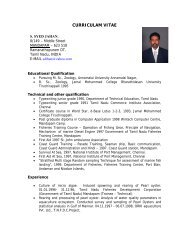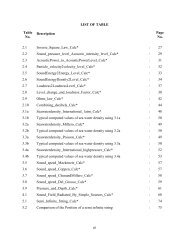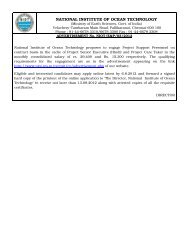Marine Bioinformatics - NIOT
Marine Bioinformatics - NIOT
Marine Bioinformatics - NIOT
Create successful ePaper yourself
Turn your PDF publications into a flip-book with our unique Google optimized e-Paper software.
organisms living in normal to extreme environments (extremophiles) have useful<br />
characteristics yet to be discovered from their wide array of biomolecules. The marine<br />
environment is the exceptional reservoir of bioactive natural product, many of which<br />
exhibit structural or chemical features not found in terrestrial natural products (Carte,<br />
1996). The protein, DNA and other compounds isolated from these organisms holds<br />
the key for useful enzymes, biomolecules, biomaterials, bioprocess etc., could be used<br />
for the development of industrial and pharmaceutical products.<br />
<strong>Marine</strong> bioinformatics<br />
The bioinformatics developed during eighties and defined as “the scientific discipline<br />
that encompasses all aspects of biological information acquisition, processing,<br />
storage, distribution, analysis and interpretation”. It combines the tools of Biology,<br />
Chemistry, Mathematics, Statistics, and Computer Sciences to understand life and its<br />
processes. The term <strong>Marine</strong> <strong>Bioinformatics</strong> refers to the use of computer and<br />
networking technologies to gather, store, integrate, analyse, interpret and disseminate<br />
the marine organism's data such as organism's distribution, description, systematic<br />
classification, phylogeny, and their biomolecular structure and sequence data along<br />
with the functional aspects using marine proteomics and genomics. (Vinithkumar,<br />
2004).<br />
The bioinformatics field offers specialised analytical technology tools for both<br />
laboratory and networking technology fields to achieve the goal of finding natural<br />
bioactive compounds from marine organisms as potential drugs, antifouling<br />
compounds, biomaterials etc. It has highest implication in marine based ecology,<br />
biology, biotechnology and molecular biology, which are integrated for the gene<br />
based discovery and development of marine drugs. The marine bioinformatics<br />
includes marine genomics and marine proteomics. <strong>Marine</strong> genomics refers to any<br />
attempt to analyze or compare the entire genome complement of a species of marine<br />
origin. Similarly marine proteomics is the study of protein family derived from<br />
marine organisms. The proteome is defined as the PROTEin complement of the<br />
genOME. Proteomics is concerned with qualitative and quantitative studies of gene<br />
expression at the level of the functional proteins themselves. The pharmacogenomics<br />
is the application of genome approach and technology to the identification of drug<br />
target protein and particularly useful in the development of drugs from marine<br />
organisms.<br />
Need and use of marine bioinformatics<br />
The successful sequencing of entire human genome in the Human Genome project<br />
opened up our understating on biological systems in an unprecedented way. This was<br />
made possible due to the advancement of molecular biotechnology combined with<br />
information technology. Presently, bioinformatics techniques are widely being<br />
applied to study the land based animals, plants and humans, and also to an extent in<br />
marine based systematics, phylogenetics, genomics and proteomics.<br />
As the volume of databases for biomolecules, proteins and genes of various land<br />
and marine organisms are growing amazingly, analyzing the data and getting required<br />
results for marine organism from the common database of land, air and water is<br />
increasingly becoming complex. This is being felt when every time a search was









